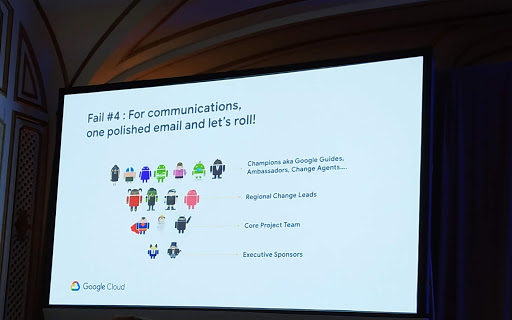
We all strive to succeed. We fill our brains with books and knowledge, we listen to podcasts of inspiring success stories, but sometimes the best way to learn is to try and fail. At Google Cloud Next ’19 in San Francisco this year, I attended a fail conference where Google’s EMEA and AMERICAS Change Management Team shared the most frequent and common mistakes reported by their teams and partners.
I thought I’d share with you some of my notes and insights into 5 common change management mistakes made during a G Suite Deployment.
Fail 1: “G Suite is a tech-y project”
When you first introduce your project to your customer, they very often first perceive it as a replacement of a technology and not of a way of rethinking and reimagining the way they work.
Why could that lead to failure? The scale of the impact of G Suite deployments is very high. If the project is seen as an IT project only, other leaders throughout the organisation won’t feel engaged in the project. As a consequence they will provide limited resources to work and support the adoption. If we focus purely on technology, then we fail to acknowledge the resistance in behaviour change.
What to do in that case? If the customer remains focused on the technical aspect of the project, change the narrative. Ask why the company decided to go G Suite? Was it for its agility, innovation, culture? These questions will help in refining vision.

Fail 2: “Leave executives alone!”
You’ll probably hear this very often: “We can’t bother execs for an IT project.” That’s why the first failure we just talked about is very common.
Why could that lead to failure? If the project is seen as a technology improvement, executives won’t be interested in taking part in it. This will lead to major downsides such as lack of support, budget and resources. Leadership also enables you to create alignment in projects and can be the face of the change.
What to do in that case? We would recommend making a stakeholder analysis: a list of all the key people for the project and analysis on how they are involved.
Fail 3: “I use Gmail at home, I don’t need training”
Providing training on G Suite tools is expensive, but the price you’ll pay for not doing it throughout your organisation will be even higher as users will lose time trying to find their own way through the tools. Users will also spend more time being frustrated and angry at the tools and lack of change management.
Why could that lead to failure? If you’re expecting your people to change their behaviour without providing the structure needed then you’re setting them up for frustration and failure.
What to do in that case? Plan the training well ahead. In planning the training you also need to be granular and specific:
- know your audience and what their specific needs are
- build a training path that enables users to learn in various ways (classroom training, Q&A, FAQ document, videos, etc)
Failure 4: “Communication is easy: let’s email!”
Generally companies prepare their communication campaign using mainly emails with boring and uncatchy titles.
Why could that lead to failure? If communication isn’t formulated correctly, it will cause questions and confusion. Project teams are then urged to rush another communication out to clarify and provide more information.
What to do in that case? In all your communications, consider these tips:
- clearly state the “why” of the change: users will engage if they catch the vision.
- make clear what are the benefits of the change to the company. In other words, “what are we doing this for”?
- “what’s in it for me?” Let the users know what they will gain from this experience.
Google (and Fourcast) would also encourage you to leverage your Google Guides. Google Guides are your change agents who will advocate your project throughout the company and within their teams. They should be empowered to be part of the bottom up communication. The more the communication approach is different, the better so that you ensure that all users have seen and understood your project.
Failure 5: “We’ve gone live…whohoo.. we’re done”
Once deployment is done and celebrated, Google very often sees that the project sponsor wants to move on to the next thing. However, this is just the beginning of the journey for most users.
Why could that lead to failure? Once users start playing with the new tool, there are still many gaps to fill: continuous learning, change management, etc. If post-go live support isn’t done, then the user experience will not be fully positive.
What to do in that case? Plan post-go live initiatives well in advance:
- assign a product owner team that continues the initiative even after you’re gone
- ensure Google Guides are continuously enabled and empowered to continue innovating and rethinking the way they work
- continue measuring success and evaluating needs of users
- ensure a continuous learning path to all users as the product is dynamic
In summary, keep in mind that your change management project impacts people. The project team should drive it with them first in mind. If you try to avoid these failures, you’ll have a bigger chance for success and a smooth G Suite deployment!
Need help with your G Suite deployment, change management or to assess whether G Suite would fit your business? We’re there to help!

